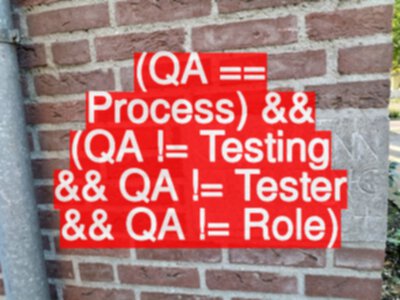TLDR; Quality Assurance is a process. It is not a role. Roles have responsibilities, and we all have a responsibility for quality. People don’t DO quality.
Quality Assurance is a Process
So what do you hear when I say QA?
Because a lot of people hear different things.
Some people will jump to testing some people will jump to tester.
Some people like me hear “Quality Assurance”, which isn’t testing and I get concerned that we don’t necessarily know how other people are going to hear or see what we put our when we use the phrase QA,
I get concerned that people are going to be confused because for me QA stands for Quality Assurance.
Not tester not testing.
QA - Quality Assurance is a process.
It is not a role. Roles have responsibilities, and we all have a responsibility for quality.
People don’t DO quality, right?
Quality is not a process.
Quality is a subjective evaluation of a thing.
But we do Implement a Quality Assurance process. Processes are things we can do, and we can take responsibility for doing them.
So, that’s our responsibility.
Our responsibility is to implement a Quality Assurance process, or a process that has quality assured, as we do it because we do it well.
QA is part of every process.
It’s not a separate process, it’s not something we do at the end, that’s called Quality Control, where we evaluate the output of a process to determine if it was good enough and then take steps to make it better through a process of process improvement.
Now if you are a QA then that’s great, congratulations on your promotion.
Because who is responsible for quality? The real answer that question is the answer to “Who is in charge?” Because that person is ultimately responsible for the quality of whatever is going on.
So if you are QA, congratulations on your promotion, I hope it goes well.
And if you didn’t get a promotion, then you ain’t a QA.
Related Thoughts
By treating QA as an over-arching concern, and as a process. We can focus on the process and its improvement. We don’t try and allocate the concept to a particular person.
When we reduce the number of definitions that a phrase has, we can communicate more clearly, with a reduced degree of ambiguity.
How many Agile books have you read that have referred to “Testing” as both QA and Testing, and “Testers” as Testers and QA?
And do they, in the same breath describe the ongoing process of making sure everything as working well as QA? … OK so I’ve rarely seen these texts actually use QA to mean a Quality Assurance process.
Processes are not people, they are implemented by people. Roles are not people, they are implemented by people and people can do parts of many roles. The activities that a ‘role’ performs can be shared across the team. I believe that when we use our language to clearly describe the process, and when we use ‘roles’ to help us understand the activities that a team has to perform. Then we spread the work across a team and harness the abilities of each team member.
Related Material
I cover some of this in my recent Toro Cloud podcast:
And in my talk for Agile Testing Days:







